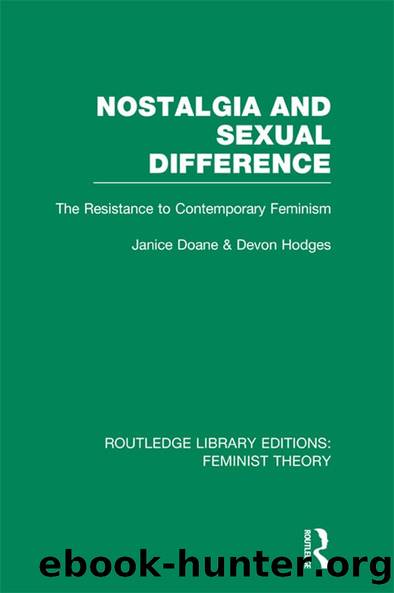Nostalgia and Sexual Difference (RLE Feminist Theory) by Janice Doane DEVON HODGES

Author:Janice Doane, DEVON HODGES [Janice Doane, DEVON HODGES]
Language: eng
Format: epub
ISBN: 9780416015317
Google: NVXwswEACAAJ
Publisher: Methuen
Published: 1987-01-15T04:46:49+00:00
Chapter Four
The Anxiety of Feminist Influence
A passionate urgency permeates Harold Bloom's works, an urgency motivated by a sense of loss and cultural decline. He, like the âstrong poetsâ he describes, is engaged in a battle against the death of Poetry, and by âPoetryâ he means a tradition, a line of influence that shapes a poet's voice, his very identity. According to Bloom, we must either acknowledge the tradition of influence he reveals or participate in the destruction of poetry itself. In A Map of Misreading (1975), Bloom tells us that he does not relish the task of bearing the bad tidings, this âGospel of Gloom,â as he calls it, but we can no longer evade the fact that âour mutual sense of canonical standards has undergone a remarkable dimming, a fading into the light of a common garishnessâ (36). What we are in danger of losing, then, is a sense of the importance of the past, of the power of the traditional literary canon. The traditional canon is, of course, male, preserved and perpetuated by strong male poets. Like Ann Douglas and John Irving, Bloom writes to inspire admiration for the power of the father's writing.
Most of the work of feminist literary critics has been to question this exclusion of women writers from the canon. Not surprisingly, Bloom suggests that âthe literature of Women's Liberationâ is implicated in âthe excessively volatile senses-of-tradition that have made canon-formation so uncertain a process . . . particularly during the last twenty yearsâ (MM 36). Bloom's response to these volatile redefinitions of the canon is to insist not only upon the traditional canon, but upon a story of its perpetuation that makes this canon seem inevitable and necessary. As the story unfolds, it becomes clear whose âvolatileâ redefinitions are the most threatening, for the story is insistently patriarchal, delineating a struggle between fathers and sons that depends for its power upon Freud's family romance, a story that is an explanation for the formation of male identity.
The chauvinism of Bloom's explanatory model has not been lost on feminist critics. Annette Kolodny argues that the psychodynamics of Bloom's paradigm render women invisible except as whore/mother Muses to male power, and argues for âanother tradition entirely,â âthat in which women taught one another how to read and write about and out of their own unique (and sometimes isolated) contextsâ (465).1 Other feminist literary critics have also responded to Bloom's male paradigm of literary influence by calling for a different, female paradigm. Our analysis addresses the problematic assumption of grounding writing in these sexual oppositions both Bloom and his feminist critics advocate.
But is Bloom really capable of articulating a closed masculine system? Bloom's paradigm is a defense against the feminization of authority, but a defense that finally bends and cracks under the passionate attempt to make it work. Though Bloom's narrative is designed to create the illusion of an autonomous male sphere of self and text, Bloom fails in his efforts to repress the feminine, which for him is the other that threatens masculine identity.
Download
This site does not store any files on its server. We only index and link to content provided by other sites. Please contact the content providers to delete copyright contents if any and email us, we'll remove relevant links or contents immediately.
4 3 2 1: A Novel by Paul Auster(11791)
The handmaid's tale by Margaret Atwood(7450)
Giovanni's Room by James Baldwin(6810)
Asking the Right Questions: A Guide to Critical Thinking by M. Neil Browne & Stuart M. Keeley(5357)
Big Magic: Creative Living Beyond Fear by Elizabeth Gilbert(5353)
Ego Is the Enemy by Ryan Holiday(4958)
On Writing A Memoir of the Craft by Stephen King(4664)
The Body: A Guide for Occupants by Bill Bryson(4584)
Ken Follett - World without end by Ken Follett(4444)
Bluets by Maggie Nelson(4261)
Adulting by Kelly Williams Brown(4235)
Eat That Frog! by Brian Tracy(4149)
Guilty Pleasures by Laurell K Hamilton(4118)
White Noise - A Novel by Don DeLillo(3829)
The Poetry of Pablo Neruda by Pablo Neruda(3816)
Fingerprints of the Gods by Graham Hancock(3738)
Alive: The Story of the Andes Survivors by Piers Paul Read(3731)
The Book of Joy by Dalai Lama(3698)
The Bookshop by Penelope Fitzgerald(3619)
